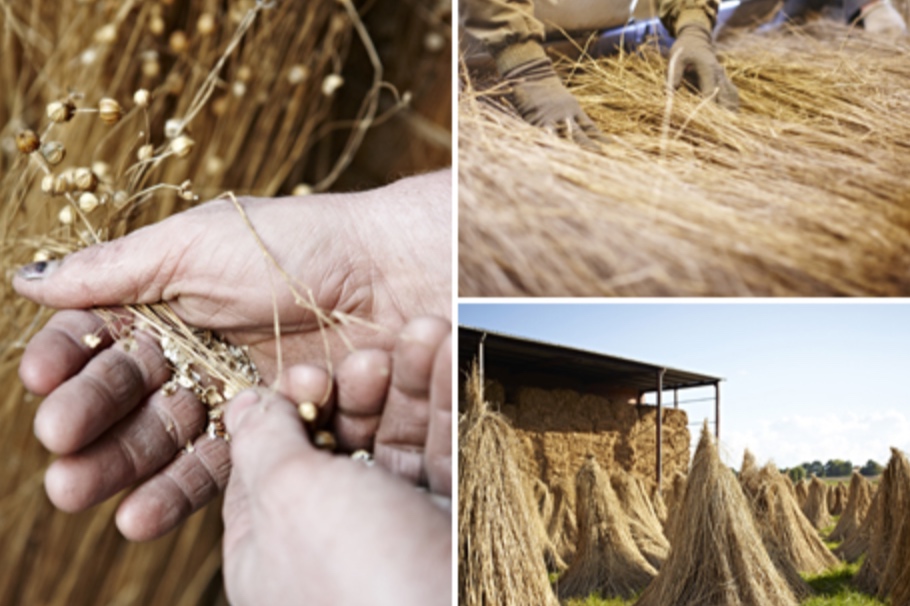Linen is a natural fiber made from the flax plant. It’s breathable, lightweight, soft, luxurious, and… one of the most environmentally sustainable fabrics. It doesn’t require any pesticides and every part of the plant is used. Linen is organic, biodegradable, and recyclable.
Fast Flax Facts!
The word linen is derived from the Latin for the flax plant, which is linum, and the earlier Greek linon. Linen is one of the world's oldest fabrics.
Mummies have been found wrapped in linen shrouds dating as far back as 4500 B.C.
Flax yarns and fabrics increase about 20% in strength on wetting.
Linen has become a favorite eco-friendly material recently, and for good reason. It’s been lauded for hundreds of years due to its durability.
As a fabric it’s breathable, durable, lightweight, absorbent, antimicrobial, moth-resistant, and cool (as in it lowers your body temperature in summer, as opposed to cotton). In terms of sustainability, it requires far less water than cotton and doesn’t require any chemical fertilizers or pesticides. ALSO, It's biodegradable, too.
Conventional linen is processed into fiber from the raw flax crop through a process of water-retting. This involves soaking the flax crop in rivers or waterways, and results in a high amount of pollutants making their way into the waterways. These include residual agro-chemicals, as well as natural waste.
Linen plant harvesting
There are more eco-friendly methods of processing. These are dew-retting and enzyme-retting. These processes turn the raw crop into fiber while avoid(ing) the water pollution associated with the water-retting process.
Linen is expensive because it's hard to weave. Linen fiber is inelastic and easy to break in the production process, that's why its cost of production is higher than most other fabrics.
Cotton can be quite soft and silky straight out its packaging, whereas linen tends to be slightly stiffer. When washed and cared for correctly cotton fabric will last around 3-5 years, before showing signs of wear. Linen fabric, however, becomes better with age - it is really only starting to shine after 3 years of usage.
Given how quickly it will dry, and its tendency to shrink when exposed to heat, air drying is your best bet when it comes to your linen clothes.
Fighting with Linen for the most sustainable fabric is the one and only, hemp. Often misunderstood. Hemp is the most versatile plant on the planet. It is the only plant that can nourish you, clothe you, create paper materials for you, and provide you with natural beauty products.
Like linen, hemp is breathable, warm, moisture-wicking, antibacterial, and can be easily blended. It’s a very durable fabric that becomes softer with washing and wear, and it’s biodegradable at the end of its life. Beyond that, the hemp plant doesn't require a lot of water, and it can produce two to three times more fiber per acre than cotton. It actually replenishes the soil it grows in rather than extracting its nutrients. From a sustainability perspective, linen and hemp are the best options we have for fabric.
I decided to pick mostly linen clothing pieces from Gudrun’s spring 2019 collection and the quality is outstanding. The above photo displays a knitted tunic that is 100% linen. (Bonus: It has pockets!) This breathable tunic has the most incredible drape and is completely breathable. Intrigued? Click here
Another one of my favorites from Gudrun’s spring 2019 collection is the “Artist’s Blouse” pictured above. It has beautiful embroidery details on the pockets and sleeves and is, you guessed it! 100% Linen! See the blouse here
Gudrun uses a brilliant sustainability standard and marks each piece online with a specific ‘eco-label’, so the consumer can immediately tell how environmentally sustainable each article of clothing is in which they are buying.
See below for a quick overview of the eco icons used for each Gudrun style
If you want to see more of Gudrun’s Eco labelling click here





